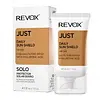What's inside
What's inside
 Key Ingredients
Key Ingredients

 Benefits
Benefits

 Concerns
Concerns

 Ingredients Side-by-side
Ingredients Side-by-side

Water
Skin ConditioningGlycerin
HumectantSqualane
EmollientDimethicone
EmollientZea Mays Starch
AbsorbentNiacinamide
SmoothingPentylene Glycol
Skin ConditioningAmmonium Polyacryloyldimethyl Taurate
Emulsion StabilisingBifida Ferment Lysate
Skin ConditioningMyristyl Myristate
EmollientButylene Glycol
HumectantTin Oxide
AbrasiveStearic Acid
CleansingPotassium Cetyl Phosphate
EmulsifyingGlyceryl Stearate Se
EmulsifyingSodium Hydroxide
BufferingMyristic Acid
CleansingPalmitic Acid
EmollientAscorbyl Glucoside
AntioxidantHydroxyacetophenone
AntioxidantCaprylyl Glycol
EmollientTetrasodium Glutamate Diacetate
Lactic Acid
BufferingAcetic Acid
BufferingXanthan Gum
EmulsifyingSynthetic Fluorphlogopite
Tocopherol
AntioxidantSodium Benzoate
MaskingCI 47005
Cosmetic ColorantCI 77891
Cosmetic ColorantCI 15510
Cosmetic ColorantParfum
MaskingWater, Glycerin, Squalane, Dimethicone, Zea Mays Starch, Niacinamide, Pentylene Glycol, Ammonium Polyacryloyldimethyl Taurate, Bifida Ferment Lysate, Myristyl Myristate, Butylene Glycol, Tin Oxide, Stearic Acid, Potassium Cetyl Phosphate, Glyceryl Stearate Se, Sodium Hydroxide, Myristic Acid, Palmitic Acid, Ascorbyl Glucoside, Hydroxyacetophenone, Caprylyl Glycol, Tetrasodium Glutamate Diacetate, Lactic Acid, Acetic Acid, Xanthan Gum, Synthetic Fluorphlogopite, Tocopherol, Sodium Benzoate, CI 47005, CI 77891, CI 15510, Parfum
Water
Skin ConditioningEthylhexyl Dimethyl Paba
UV AbsorberEthylhexyl Salicylate
UV AbsorberButyl Methoxydibenzoylmethane
UV AbsorberTerephthalylidene Dicamphor Sulfonic Acid
UV AbsorberPhenylbenzimidazole Sulfonic Acid
UV AbsorberC12-15 Alkyl Benzoate
AntimicrobialCaprylic/Capric Triglyceride
MaskingGlycerin
HumectantZinc Oxide
Cosmetic ColorantBis-Ethylhexyloxyphenol Methoxyphenyl Triazine
Skin ConditioningCetearyl Alcohol
EmollientGlycol Cetearate
EmollientGlyceryl Stearate
EmollientCeteareth-20
CleansingCeteareth-12
EmulsifyingCetyl Palmitate
EmollientSodium Hyaluronate
HumectantPhenoxyethanol
PreservativeAllantoin
Skin ConditioningAcrylates/C10-30 Alkyl Acrylate Crosspolymer
Emulsion StabilisingTriethanolamine
BufferingParfum
MaskingWater, Ethylhexyl Dimethyl Paba, Ethylhexyl Salicylate, Butyl Methoxydibenzoylmethane, Terephthalylidene Dicamphor Sulfonic Acid, Phenylbenzimidazole Sulfonic Acid, C12-15 Alkyl Benzoate, Caprylic/Capric Triglyceride, Glycerin, Zinc Oxide, Bis-Ethylhexyloxyphenol Methoxyphenyl Triazine, Cetearyl Alcohol, Glycol Cetearate, Glyceryl Stearate, Ceteareth-20, Ceteareth-12, Cetyl Palmitate, Sodium Hyaluronate, Phenoxyethanol, Allantoin, Acrylates/C10-30 Alkyl Acrylate Crosspolymer, Triethanolamine, Parfum
 Reviews
Reviews

Ingredients Explained
These ingredients are found in both products.
Ingredients higher up in an ingredient list are typically present in a larger amount.
Glycerin is already naturally found in your skin. It helps moisturize and protect your skin.
A study from 2016 found glycerin to be more effective as a humectant than AHAs and hyaluronic acid.
As a humectant, it helps the skin stay hydrated by pulling moisture to your skin. The low molecular weight of glycerin allows it to pull moisture into the deeper layers of your skin.
Hydrated skin improves your skin barrier; Your skin barrier helps protect against irritants and bacteria.
Glycerin has also been found to have antimicrobial and antiviral properties. Due to these properties, glycerin is often used in wound and burn treatments.
In cosmetics, glycerin is usually derived from plants such as soybean or palm. However, it can also be sourced from animals, such as tallow or animal fat.
This ingredient is organic, colorless, odorless, and non-toxic.
Glycerin is the name for this ingredient in American English. British English uses Glycerol/Glycerine.
Learn more about GlycerinParfum is a catch-all term for an ingredient or more that is used to give a scent to products.
Also called "fragrance", this ingredient can be a blend of hundreds of chemicals or plant oils. This means every product with "fragrance" or "parfum" in the ingredients list is a different mixture.
For instance, Habanolide is a proprietary trade name for a specific aroma chemical. When used as a fragrance ingredient in cosmetics, most aroma chemicals fall under the broad labeling category of “FRAGRANCE” or “PARFUM” according to EU and US regulations.
The term 'parfum' or 'fragrance' is not regulated in many countries. In many cases, it is up to the brand to define this term.
For instance, many brands choose to label themselves as "fragrance-free" because they are not using synthetic fragrances. However, their products may still contain ingredients such as essential oils that are considered a fragrance by INCI standards.
One example is Calendula flower extract. Calendula is an essential oil that still imparts a scent or 'fragrance'.
Depending on the blend, the ingredients in the mixture can cause allergies and sensitivities on the skin. Some ingredients that are known EU allergens include linalool and citronellol.
Parfum can also be used to mask or cover an unpleasant scent.
The bottom line is: not all fragrances/parfum/ingredients are created equally. If you are worried about fragrances, we recommend taking a closer look at an ingredient. And of course, we always recommend speaking with a professional.
Learn more about ParfumWater. It's the most common cosmetic ingredient of all. You'll usually see it at the top of ingredient lists, meaning that it makes up the largest part of the product.
So why is it so popular? Water most often acts as a solvent - this means that it helps dissolve other ingredients into the formulation.
You'll also recognize water as that liquid we all need to stay alive. If you see this, drink a glass of water. Stay hydrated!
Learn more about Water